The Saunders Research Onion, which was created by Saunders et al., is a visual representation of the stages that make up the growth of a research project and is a wonderful basic research methodology. Here, using the techniques, researching is one of the fundamental skills which are renowned worldwide. In another way of putting it, the onion layers give a more complete picture of the stages of the study process. It gives a step-by-step plan that makes it easier to come up with a study technique. This tool is useful because it can be changed to work with almost all study methods and can be used in many different situations (Bryman, 2012). Saunders et al. (2012) say that to use the study onion, you have to work your way from the very top to the very bottom. The top layer of the onion shows more information about each step of the study process (Saunders et al., 2019). In their paper, Saunders et al. compare the study process to pulling back the layers of an onion. The top layer has to be removed before the deepest layer can be seen. To get the result you want, you have to take the right steps. This is also true in study; you must finish one step before moving on to the next.
Table of Contents
Several layers form the Saunders onion investigation
When using this method, it is recommended to work your way from the outside to the inside of the study onion.
The research theory, which establishes the framework for the research process and determines the methodology to be employed in the subsequent phase, occupies the highest level. The methods for the study are determined in the third phase, while the schedule is established in the fourth.
With the approach of the fifth stage, the method for data collection is ultimately selected. The research onion is a valuable tool as it delineates the various approaches to data collection into a series of comprehensible phases. It also illustrates the procedural components that comprise a scientific investigation.
![Saunders et al.'s Research Onion [30]. | Download Scientific Diagram](https://www.researchgate.net/publication/349316382/figure/fig2/AS:991459658457088@1613393811116/Saunders-et-als-Research-Onion-30.jpg)
The following constitute Saunders’ study onion:
- Research Philosophy
- Research Approach
- Research strategies
- Research Choice
- Research time horizon
1. Research Philosophy
According to Bryman (2012), the study theory is the set of beliefs about what the world being studied is really like. In its simplest form, it describes what knowledge is all about. Additionally, different research theories may exist when it comes to the goals of research and the best ways to reach those goals (Goddard & Melville, 2004). Even though these might not naturally be at odds with each other, the type of information being studied in a given project determines which research theory is best (May 2011).
When it comes to the study process, three main theories are very important.
Ontology:
Ontology is the study of the nature of reality and existence. In research, ontology concerns the assumptions researchers make about the nature of the world and what constitutes reality.
- Realism: Assumes that reality exists independently of human perceptions and beliefs. There is a single, objective reality that can be observed and described.
- Relativism: Believes that reality is not objective and is constructed by social, cultural, or individual perspectives. Multiple realities exist depending on different viewpoints.
- Nominalism: This suggests that universals and abstract concepts do not exist independently of human thought. Only specific, individual objects are real.
Epistemology:
Epistemology is the study of knowledge and how it is acquired. It deals with the nature and scope of knowledge and what constitutes valid knowledge in research.
- Positivism: Emphasizes observable, empirical evidence and the scientific method. Knowledge is derived from sensory experience and can be measured objectively.
- Interpretivism: Focuses on understanding the meaning and context of human behaviour. Knowledge is seen as subjective and constructed through interaction and interpretation.
- Constructivism: Argues that knowledge is actively constructed by individuals rather than passively received from the environment. Learning is an adaptive process of making sense of experiences.
- Pragmatism: Suggests that the truth of a theory or belief lies in its practical consequences and usefulness. Knowledge is evaluated based on its effectiveness in solving problems.
Positivism, realism, and interpretivism are all parts of philosophy, according to Bryman (2012). Positivism uses study questions that can be tested. It makes explanations easier by using the accumulated information that most people agree on. New study methods can be used when realism is used. You have to research before you can know the truth. The only difference between positivism and realism is that positivism supports the scientific process and realism does not. Interpretivism helps us figure out how people think about their own and other people’s actions. It is helpful to understand other people’s cultures and how they interact with others.
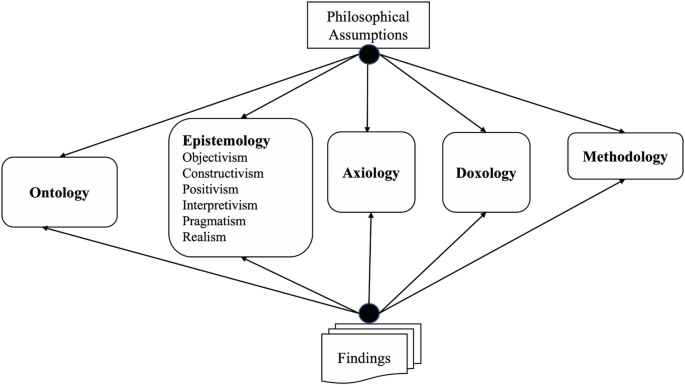
Axiology:
Axiology is the study of values and ethics in research. It examines the role of the researcher’s values in the research process and how values influence the research outcomes.
- Ethical Considerations: Involves the moral principles guiding the research process, ensuring the integrity and ethical treatment of research subjects.
- Value-Laden Inquiry: Recognizes that researchers bring their own values and biases to the research process, which can influence the choice of research topics, methods, and interpretations.
- Value-Free Inquiry: Posits that research can and should be conducted in an objective, value-neutral manner, free from the researcher’s values and biases.
Objectivism, Constructivism and Positivism
Objectivism makes you aware of a social event the different ways it can be understood and how it affects the people who are involved in it. On the other hand, constructivism doesn’t say that social players are to blame for making an event happen. On the other hand, constructivism says that each viewer or group gives social events their meaning (Östlund et al., 2011). According to this way of thinking, you can never be sure that everyone will read what you see the same way. The most important thing is to look for differences and subtleties in how people understand what you say.
Positivism comes up with hypotheses and research questions that can be tested and studied. Positivism can be used to measure and explain what most people know about the world. It can be seen in the law of gravity.
There are differences between these moral practices, but neither is better than the other. However, studies may favour one over the other (Podsakoff et al., 2012). Philosophy is just a way of explaining why the study method is right. How the observations are made should be based on what is being watched.
Beyond ontology, epistemology, and axiology, several other research philosophies shape the approach to scientific inquiry:
- Critical Realism: Combines a realist ontology with a critical epistemology, acknowledging that while there is a reality independent of our thoughts, our understanding of it is always mediated by social and cultural factors.
- Postmodernism: Challenges the idea of a single, overarching reality or truth. Emphasizes the fragmented, subjective nature of knowledge and the role of power and discourse in shaping understanding.
- Feminism: Highlights how traditional research methodologies have marginalized women and other oppressed groups. Advocates for methodologies that are inclusive and that highlight issues of gender, power, and inequality.
- Postcolonialism: Examines the impact of colonialism on knowledge production and advocates for methodologies that are sensitive to the contexts and experiences of formerly colonized peoples.
- Phenomenology: Focuses on understanding human experiences from the first-person perspective. Emphasizes the subjective, lived experiences of individuals.
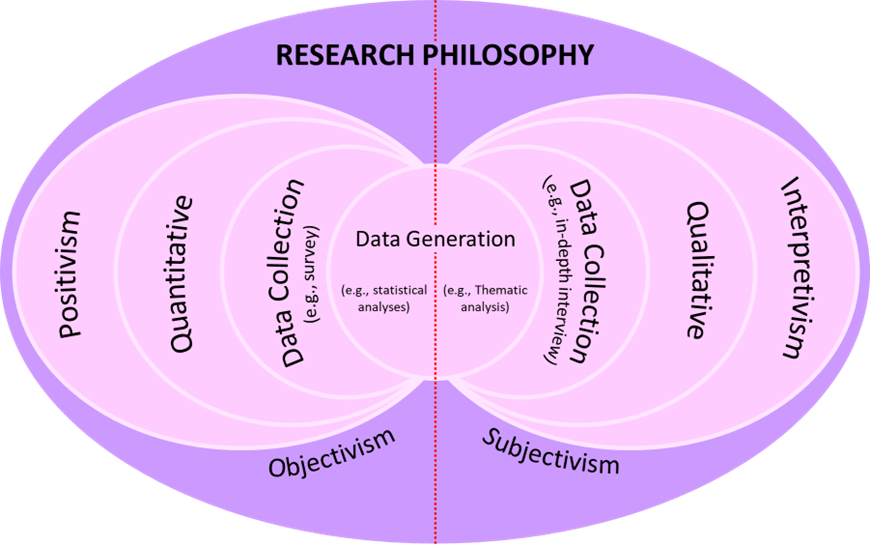
2. Research Approach
There are two types of words in the second layer of the study onion: deductive and inductive. This layer of the onion is affected by the layer below it, so it’s important to know what the study aims to do and what it can’t do.
Deductive Research Approach
Deductive reasoning starts with a general theory or hypothesis and then tests it through the collection of data to see if the theory holds true in specific instances.
- Theory: Researchers begin with an established theory or set of hypotheses.
- Hypothesis Formation: Based on the theory, researchers create specific, testable hypotheses.
- Data Collection: Researchers collect data to test these hypotheses.
- Analysis: Researchers analyze the data to see if it supports or refutes the hypotheses.
- Conclusion: Based on the analysis, researchers conclude the validity of the original theory.
Example: A psychologist testing a theory about human behaviour might start with a hypothesis such as “stress reduces cognitive performance.” They would then design an experiment to test this hypothesis and analyze the results to confirm or refute it.
Advantages:
- Provides a clear, structured approach to research.
- Allows for hypothesis testing and confirmation of theories.
Disadvantages:
- Rigid, as it requires the researcher to adhere to the initial theory.
- May overlook new or unexpected findings that do not fit the hypothesis.
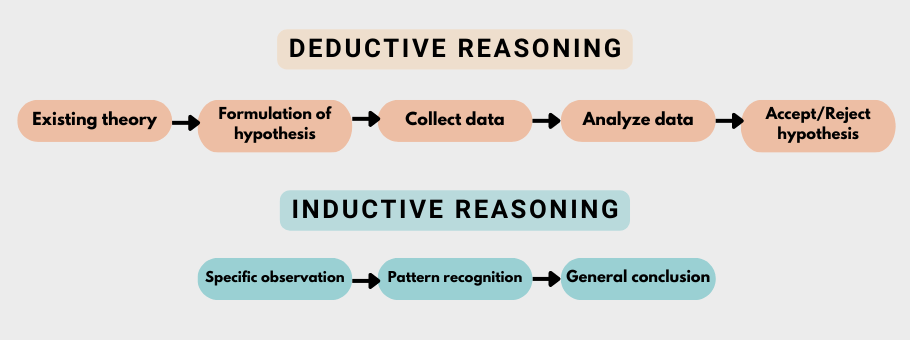
Inductive Research Approach
Inductive reasoning involves starting with specific observations and measures, detecting patterns and regularities, formulating some tentative hypotheses that can be explored, and finally developing general conclusions or theories.
- Observation: Researchers begin by collecting data and observing phenomena without preconceived theories or hypotheses.
- Pattern Recognition: As data is collected, researchers look for patterns, regularities, and consistencies within the data.
- Hypothesis Formation: Based on the identified patterns, researchers formulate tentative hypotheses.
- Theory Development: From these hypotheses, researchers develop broader generalizations and theories.
Example: A sociologist studying a new subculture might begin by observing its members and their behaviours. Over time, they might notice patterns in these behaviours and develop a theory about the subculture’s norms and values.
Advantages:
- Flexible, as it allows for changes and adjustments based on observations.
- Useful in exploratory research where little is known about the subject.
Disadvantages:
- Can be time-consuming and may lack direction without initial hypotheses.
- This may lead to incorrect conclusions if patterns are incorrectly interpreted.
3. Research Strategy
The study approach describes in detail how the investigator intends to conduct the investigation (Saunders et al., 2007). A comprehensive literature review, experiments, action research, case study research, interviews, and questionnaires are a few of the numerous applications of this method. It’s a combination of research design with the actual study which is conducted methodologically.
Version test
Experimental research proposes a methodology for conducting investigations in which the outcomes of an experiment are contrasted with the predictions that were made. The majority of the time, this method examines only a few aspects and applies to any field of study (Saunders et al., 2007).
Surveying
Frequently, the logical method is associated with the study of Onion’s survey technique. It is among the most efficient and economical methods of studying. By employing this approach, one can acquire a wealth of valuable information. Surveys are frequently employed in quantitative research endeavours. An in-depth examination of a population is conducted using a representative sample (Bryman & Bell, 2011). The survey method is predominantly employed to examine the factors that influence various data points. It enables the collection of a substantial amount of data that will be utilised to address the research inquiry.
Case Study
This strategy targets one or more individuals or a specific location. This can demonstrate the significance of circumstances and society in distinguishing cases and aid in comprehending what makes each case special (Silverman, 2013). This technique is more effective when researching money. Case study research examines a solitary unit to ascertain its distinctive characteristics and to determine how overarching conclusions can be drawn (Bryman, 2012). This form of investigation is highly effective in the realm of financial research, particularly when comparing the performance of investments across various scenarios or contrasting the experiences of two companies.
Action Research
Action research is a prevalent form of inquiry utilised in disciplines such as nursing and education, wherein practitioners seek to enhance their professional approach and understanding (Wiles et al., 2011). A primary motivation for employing this methodology is to devise a solution to a given dilemma.
4. Research Choice
Research choice, also known as the research methodology or research approach, involves selecting the overall strategy and methods that will be used to address the research question. This choice dictates how the research will be conducted, including how data will be collected, analyzed, and interpreted. The research choice is guided by the nature of the research question, the objectives of the study, and the type of data required. Here are the primary research choices:

Types of Research Choices
- Qualitative Research:
- Purpose: To explore complex phenomena, understand meanings, and gain insights into experiences, behaviours, and interactions.
- Methods: Interviews, focus groups, observations, case studies, and content analysis.
- Data: Non-numeric, descriptive data such as words, images, and objects.
- Advantages: Provides in-depth understanding, captures rich detail, flexible and adaptive.
- Disadvantages: Subjective interpretation, harder to generalize, time-consuming.
- Quantitative Research:
- Purpose: To quantify variables, test hypotheses, and establish patterns and relationships through statistical analysis.
- Methods: Surveys, experiments, structured observations, and secondary data analysis.
- Data: Numeric data that can be measured and analyzed statistically.
- Advantages: Objective measurement, easier to replicate and generalize, efficient for large samples.
- Disadvantages: May miss contextual details, less flexible, requires large sample sizes for statistical significance.
- Mixed Methods Research:
- Purpose: To combine the strengths of both qualitative and quantitative approaches, providing a comprehensive understanding.
- Methods: Sequential or concurrent use of qualitative and quantitative methods (e.g., surveys followed by interviews, or simultaneous collection of both types of data).
- Data: Both numeric and non-numeric data.
- Advantages: Balances depth and breadth, more robust conclusions, triangulates data for validation.
- Disadvantages: More complex and time-consuming, requires expertise in both methodologies, can be resource-intensive.
Choosing the Right Research Methodology
- Define the Research Problem and Objectives:
- Clearly articulate what you aim to investigate and what you hope to achieve.
- Consider the Nature of the Research Question:
- Exploratory Questions: Often suited to qualitative research.
- Explanatory Questions: Typically suited to quantitative research.
- Descriptive Questions: Can be addressed by either qualitative or quantitative research, depending on the level of detail required.
- Review Existing Literature:
- Understand the approaches used in previous studies on similar topics to inform your choice.
- Evaluate Resource Availability:
- Consider the time, budget, and expertise available to you. Qualitative research often requires more time for data collection and analysis, while quantitative research may need more resources for data collection and statistical software.
- Determine the Type of Data Needed:
- Decide whether you need numerical data to measure and analyze statistically (quantitative) or descriptive data to provide in-depth understanding (qualitative).
- Consider Ethical Implications:
- Ensure that the chosen methodology respects the rights and well-being of participants.
- Decide on a Mixed Methods Approach if Necessary:
- If both depth and breadth are important, and resources allow, consider using a mixed methods approach to leverage the advantages of both qualitative and quantitative research.
Example Scenarios for Research Choice
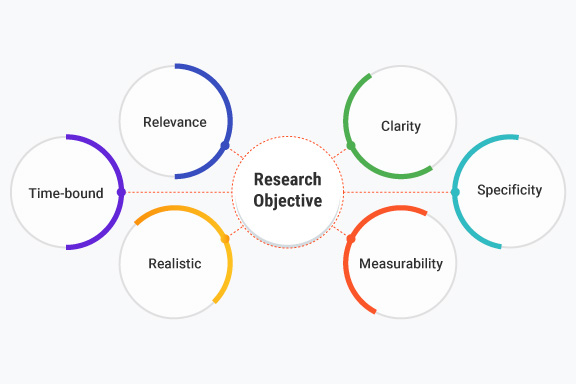
Example 1: Qualitative Research
- Research Topic: Understanding the experiences of remote workers during the COVID-19 pandemic.
- Research Question: How do remote workers perceive the impact of remote work on their work-life balance?
- Methodology: Conduct in-depth interviews with remote workers to explore their experiences and perceptions.
Example 2: Quantitative Research
- Research Topic: The effect of remote work on productivity in the IT industry.
- Research Question: Does remote work lead to higher productivity among IT professionals compared to office-based work?
- Methodology: Distribute surveys with productivity metrics to a large sample of IT professionals and analyze the data statistically.
Example 3: Mixed Methods Research
- Research Topic: The impact of remote work on employee well-being and productivity.
- Research Question: How does remote work influence both the well-being and productivity of employees in the IT sector?
- Methodology: Use surveys to gather quantitative data on productivity and well-being, followed by focus group discussions to gain qualitative insights into the factors influencing these outcomes.
Choosing the right research methodology is crucial for ensuring that the study effectively addresses the research question and meets its objectives. By carefully considering the nature of the research problem, the type of data needed, and the resources available, researchers can select an appropriate approach that provides valid and reliable results.
5. Time Horizon
6. Analysis & Data Collection
Analysis and data collection are crucial components of the research process. Effective data collection ensures that the data gathered is relevant, accurate, and sufficient to address the research question, while data analysis involves interpreting this data to draw meaningful conclusions.
Data Collection Methods
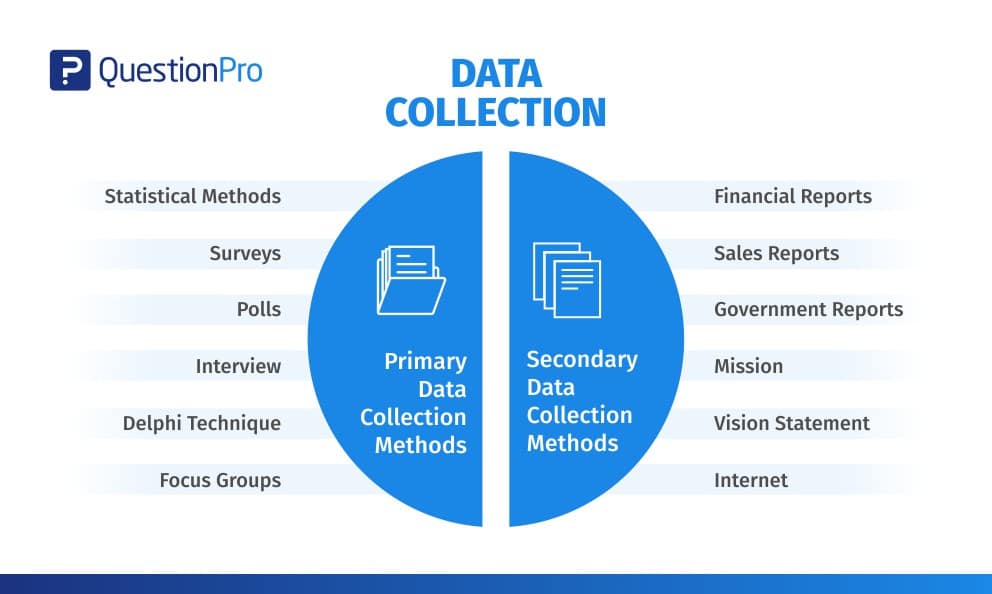
1. Quantitative Data Collection
- Surveys and Questionnaires:
- Description: Structured tools used to collect numerical data from a large number of respondents.
- Methods: Online surveys, paper questionnaires, telephone interviews.
- Advantages: Can reach a large audience, easy to analyze statistically, cost-effective.
- Disadvantages: May have low response rates, potential for bias in responses.
- Experiments:
- Description: Controlled studies designed to test hypotheses by manipulating variables.
- Methods: Laboratory experiments, field experiments.
- Advantages: High level of control over variables, can establish causality.
- Disadvantages: May lack external validity, can be resource-intensive.
- Observations:
- Description: Systematic recording of observable behaviors or events.
- Methods: Structured observation, checklists.
- Advantages: Direct data collection, can capture natural behaviors.
- Disadvantages: Observer bias, may be time-consuming.
- Secondary Data Analysis:
- Description: Use of existing data collected for other purposes.
- Methods: Analyzing government reports, organizational records, previous research datasets.
- Advantages: Cost-effective, time-saving.
- Disadvantages: Limited control over data quality, may not perfectly align with research objectives.
2. Qualitative Data Collection
- Interviews:
- Description: In-depth, open-ended conversations to explore participants’ perspectives.
- Methods: Face-to-face, telephone, or online interviews.
- Advantages: Provides detailed insights, flexible, allows for probing deeper.
- Disadvantages: Time-consuming, potential for interviewer bias.
- Focus Groups:
- Description: Guided discussions with a small group of participants to explore specific topics.
- Methods: In-person or virtual group discussions.
- Advantages: Rich, interactive data, can reveal group dynamics.
- Disadvantages: Groupthink, requires skilled moderation.
- Observations:
- Description: Detailed, qualitative recording of behaviors and interactions.
- Methods: Participant observation, ethnography.
- Advantages: Provides context-rich data, captures real-time behaviors.
- Disadvantages: Observer bias, time-consuming, ethical considerations.
- Document Analysis:
- Description: Systematic examination of existing documents to gather qualitative data.
- Methods: Analyzing texts, reports, media articles, historical records.
- Advantages: Non-intrusive, can provide comprehensive historical context.
- Disadvantages: May lack depth if documents are not detailed, potential bias in document selection.
Data Analysis Methods

1. Quantitative Data Analysis
- Descriptive Statistics:
- Description: Summarizing and describing the features of a dataset.
- Methods: Mean, median, mode, standard deviation, frequency distributions.
- Advantages: Provides a clear overview of the data, simple to compute and interpret.
- Disadvantages: Does not allow for inferential conclusions.
- Inferential Statistics:
- Description: Making inferences about a population based on a sample.
- Methods: Hypothesis testing, regression analysis, ANOVA, chi-square tests.
- Advantages: Allows for generalizations, tests relationships between variables.
- Disadvantages: Requires assumptions about the data, complexity in interpretation.
- Multivariate Analysis:
- Description: Examining relationships between multiple variables simultaneously.
- Methods: Multiple regression, factor analysis, MANOVA.
- Advantages: Can handle complex data, reveals interactions between variables.
- Disadvantages: Complex, requires advanced statistical knowledge.
2. Qualitative Data Analysis
- Thematic Analysis:
- Description: Identifying and analyzing patterns or themes within qualitative data.
- Methods: Coding data, identifying themes, interpreting themes.
- Advantages: Flexible, can handle large volumes of text, provides in-depth insights.
- Disadvantages: Subjective, time-consuming.
- Content Analysis:
- Description: Systematic coding and categorizing of text data to identify patterns.
- Methods: Coding schemes, frequency counts of themes or keywords.
- Advantages: Quantifies qualitative data, systematic and replicable.
- Disadvantages: May miss context, limited to manifest content.
- Narrative Analysis:
- Description: Analyzing the stories or accounts told by participants to understand their experiences.
- Methods: Identifying story structures, thematic elements, and narrative techniques.
- Advantages: Provides deep understanding of individual experiences, captures complexity.
- Disadvantages: Interpretive, time-consuming.
- Grounded Theory:
- Description: Developing a theory grounded in data systematically gathered and analyzed.
- Methods: Open coding, axial coding, selective coding.
- Advantages: Generates new theories, systematic and iterative.
- Disadvantages: Requires substantial data, complex process.
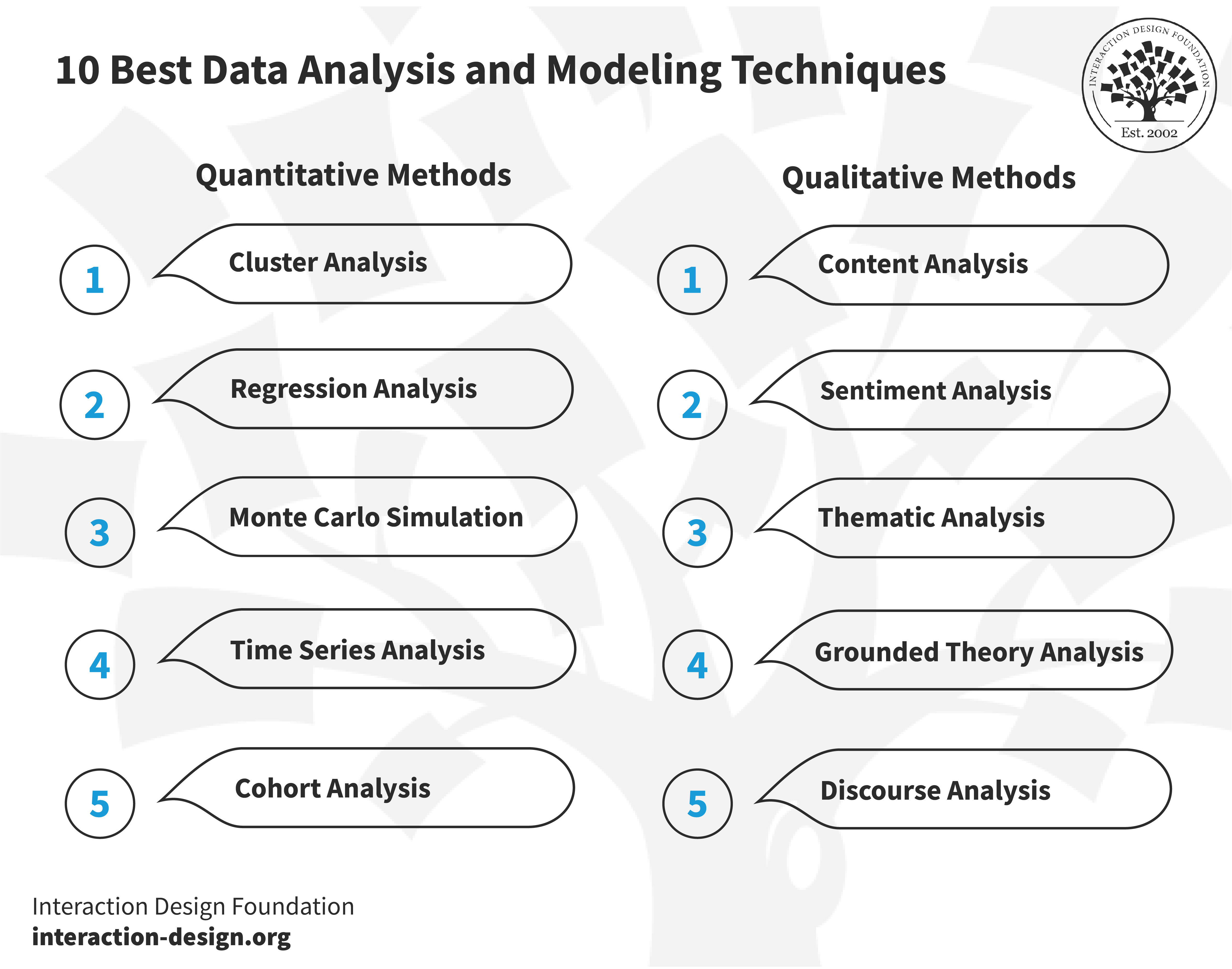
Example of a Research Project
Research Topic: Impact of Remote Work on Employee Productivity
- Data Collection Methods:
- Surveys: Quantitative data on productivity levels, work habits, and employee satisfaction.
- Interviews: Qualitative insights into personal experiences, challenges, and benefits of remote work.
- Document Analysis: Review of company reports on productivity metrics and remote work policies.
- Data Analysis Methods:
- Descriptive Statistics: Summarize survey results, average productivity scores.
- Inferential Statistics: Test hypotheses on the impact of remote work on productivity, compare with office-based work.
- Thematic Analysis: Identify common themes from interview transcripts, such as work-life balance, communication issues, and job satisfaction.
- Content Analysis: Quantify mentions of specific challenges or benefits in interview and document data.
Integrating Data Collection and Analysis
- Plan Data Collection: Design surveys and interview guides, determine sampling strategies, schedule data collection.
- Collect Data Systematically: Ensure consistency in survey distribution, interview conduction, and document review.
- Prepare Data for Analysis: Transcribe interviews, clean and organize survey data, create coding schemes for qualitative data.
- Analyze Data: Conduct statistical tests, code qualitative data, identify patterns and themes.
- Interpret Results: Combine quantitative and qualitative findings to draw comprehensive conclusions.
- Report Findings: Present data in tables, graphs, and narrative form, highlighting key insights and implications.
By carefully selecting and executing data collection and analysis methods, researchers can ensure that their study produces reliable, valid, and meaningful results.

